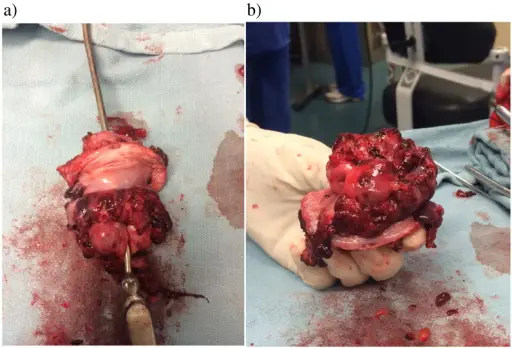Embryonal rhabdomyosarcoma of the vagina with Botryoid type’ is a rare soft tissue tumor that arises within the wall of the bladder or vagina and seen almost exclusively in infants.
What is the Pathology of Vaginal Embryonal Rhabdomyosarcoma?
The pathology of vaginal embryonal rhabdomyosarcoma is:
-Etiology: The cause of vaginal embryonal rhabdomyosarcoma is changes in the genetic material in cells DNA.
-Genes involved: IGF2, ATR, PTCH, CDKN2A P16 INK4A, CDKN2B, and TP53
-Pathogenesis: The sequence of events that lead to vaginal embryonal rhabdomyosarcoma are disruption of skeletal muscle progenitor cell growth and related differentiation may cause rhabdomyosarcoma.
-Morphology: The morphology associated with vaginal embryonal rhabdomyosarcoma shows small, round tumor cells with hyperchromatic nuclei.
-Histology: The histology associated with vaginal embryonal rhabdomyosarcoma shows large, polygonal-shaped tumor cells with abundant eosinophilic cytoplasm.
How does Vaginal Embryonal Rhabdomyosarcoma Present?
Patients with vaginal embryonal rhabdomyosarcoma typically females at the neonatal age. The symptoms, features, and clinical findings associated with vaginal embryonal rhabdomyosarcoma include swelling, pain, urination trouble, feeling of a mass in the introitus, vaginal bleeding and pelvic pain, leucorrhea and malodorous discharge.
How is Vaginal Embryonal Rhabdomyosarcoma Diagnosed?
Vaginal embryonal rhabdomyosarcoma is diagnosed by: biopsy, genetic tests for tumor tissues, immunocytochemistry tests.
How is Vaginal Embryonal Rhabdomyosarcoma Treated?
Vaginal embryonal rhabdomyosarcoma is treated by combination of surgery with adjuvants chemotherapy and radiotherapy.
What is the Prognosis of Vaginal Embryonal Rhabdomyosarcoma?
The prognosis of vaginal embryonal rhabdomyosarcoma is good.



